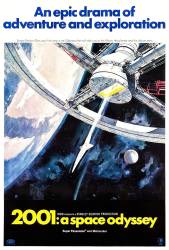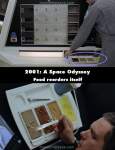Trivia: The little girl on the picture phone is director Stanley Kubrick's daughter Vivian. (00:27:50)
Trivia: The leopard lying on a dead zebra was actually lying on a dead horse painted to look like a zebra. The cat wasn't too happy with that scene.
Trivia: It has been long-rumored that Pink Floyd song 'Echoes', which clocks in at 23:27 on the album Meddle, was inspired by the 'Stargate' sequence in this film. And if placed side-by-side, they do line up near-perfectly. However, this has never been 100% confirmed.
Trivia: The Computer Science department at the Engineering School at the University of Illinois in Urbana, Illinois, have a "birthday party" for HAL every January 12th - the date & place HAL became operational in the movie.
Trivia: Many of the scenes of the expanding galaxies, as Dave was passing by them, was nothing more than paint being funneled down a tube and pouring out into a glass container full of water with a camera beneath to capture the effect.
Trivia: Both director Stanley Kubrick and author Arthur C. Clarke originally chose Jupiter as the Discovery's destination, and production of the Jupiter sequences and elaborate special effects were already finished ("in the can") when Kubrick abruptly decided to change the destination to Saturn. Kubrick thought Saturn with its rings would be more visually exciting than the Jupiter footage that he had already finished, so he ordered his special effects team to begin work on the Saturn effects. At the same time, Arthur C. Clarke changed the destination to Saturn in his "2001" novel that he was writing concurrent with the movie's production. Stanley Kubrick was well known for making such sudden and costly changes in the middle of production, but money wasn't really an issue; in fact, when Kubrick showed MGM studio heads and investors his early special effects footage, they were so awestruck that they all agreed to pay any price for the finished film. The real reason that Kubrick didn't go to Saturn was the protest of his exasperated special effects team, who had spent an enormous amount of time and effort on the already-completed Jupiter footage and had stretched their ingenuity to the point of exhaustion. The FX artists and technicians were extremely proud of their work and argued against simply discarding it to the cutting room floor. Kubrick, in typical fashion, abruptly dropped the Saturn idea without a second thought and stayed with Jupiter. (Strangely enough, Arthur C. Clarke still thought Saturn was a better destination, so he kept it in his novel, which published shortly after the movie premiered).
Trivia: There is no dialogue in the first 25 minutes or in the last 23 minutes of the film.
Trivia: The scene where Bowman is shown floating through HAL's 'brain' prior to disconnect used a stunt double in a space suit suspended by wires behind him. During one take the wires failed, dropping him to the floor and causing serious injury.
Trivia: In the 'Stargate' sequence at the end of the film, the shots that look like colored landscape is actually unused footage from Dr. Strangelove that was colorised.
Trivia: The moon pit where we see the monolith was created by dyeing 90 tons of sand. (Interview with Kier Dullea).
Trivia: Almost every company whose product was advertised in this film is no longer in business.
Trivia: In the ape or Dawn of Man portion of the film, the scenes of the landscapes were created by still projectors near the film camera with a stage in the foreground. This was obvious, in one scene, where the eyes of the leopard were glowing.
Trivia: Not only "Echoes," but also the album "Dark Side of the Moon," less the songs "Money," "Us and Them," and "Any Colour You Like," can be perfectly synchronized to the Stargate sequence.
Trivia: Alex North originally scored 2001. Kubrick eventually decided to go with classical music instead for he used classical music on his sets to set the mood for his actors.
Trivia: To film Dave Bowman's explosive transition from the pod into the Discovery, a vertical airlock set was constructed. Keir Dullea was suspended on wires and pulled to the top of the set as the camera shot upwards from below. This, combined with the establishing shot of the pod lined up with the airlock door, gave the illusion that he was floating horizontally into the ship - the wires suspending him from the ceiling were hidden behind his body.
Trivia: People speculate that HAL is a reference to IBM, as the letters differ by one position. Kubrick says this is a coincidence, but was concerned about IBM's reaction to the film's references, including the IBM logo on Bowman's spacesuit. However IBM had no problem as long as they weren't associated with the "equipment failure," or listed as technical advisors for the computer.
Suggested correction: Despite decades of rumors regarding the relationship between Kubrick's "2001: A Space Odyssey" and IBM, the fact is that IBM worked very closely with the production (assisting and advising on futuristic onscreen computer effects), and there was never any conflict or concern with IBM's reaction to the film.






